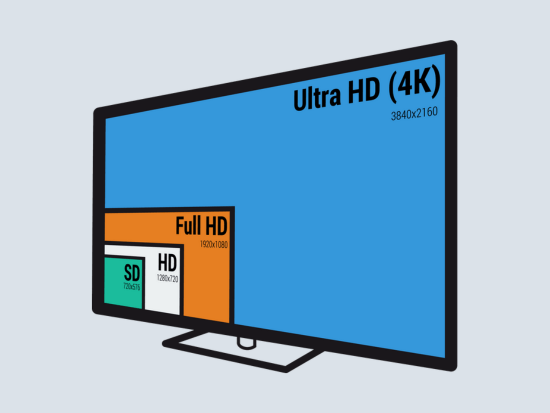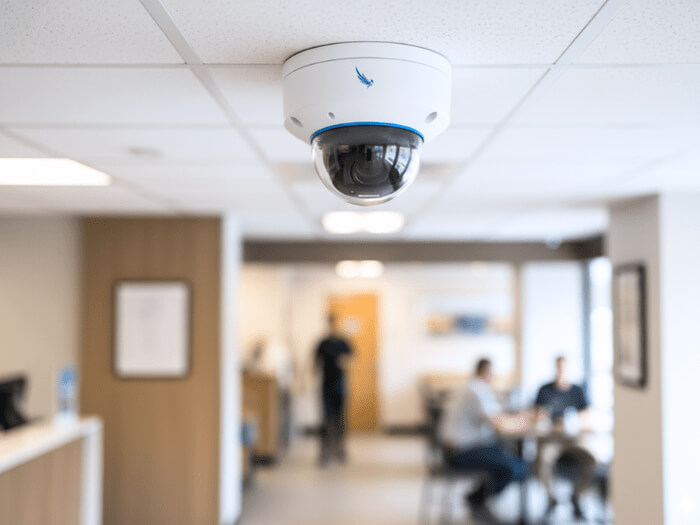
At the movies, it’s a cliche of science fiction and crime drama: a blurred or grainy surveillance image is enhanced on command, revealing a perfectly clear license plate number, a suspect’s face, or a subtle clue. Critical details are suddenly visible, and the plot moves forward.

In the real world of video surveillance, it’s not quite that simple. While advanced software can certainly clean up an image, or even combine details found in multiple frames, a fundamental truth remains: resolution is a limiting factor. Imagine zooming in with a microscope on a photograph or a screen in front of you — very soon, you’ll reach the limit of available detail.
You simply can’t capture new detail after the fact.
What is resolution in video surveillance?
Simply put, the video resolution of a surveillance camera is the measure of how much actual detail a single video frame contains. The level of this detail is expressed in pixels. A video frame with a resolution of 1920 pixels horizontally and 1,080 pixels vertically has a total of just over 2 million pixels. We often refer to this as 2 Megapixels (MP), or more commonly, Full HD. The higher the number of pixels, the greater the detail that can be captured.
Think of it like a mosaic. A mosaic made of large tiles can only show a coarse picture, while a mosaic made of millions of tiny tiles can display a sharp, intricate image.
And if you’ve bought a TV recently, you’ve seen the same phenomenon on the display side. The other thing you’ve probably noticed is this: When you’re looking at an image on screen, a high pixel count doesn’t matter if the image you see has been compressed into a blocky blur. The on-screen image is always limited by the source material. That’s just as true for surveillance video.
Typical resolutions today: IP vs. analog
The shift from older analog systems to IP (Internet Protocol) surveillance has dramatically increased the resolutions available.
- IP cameras: The current mainstream for professional IP surveillance cameras is typically in the 2 to 4 megapixel range. This provides an excellent balance of detail for general surveillance while keeping bandwidth and storage requirements manageable. However, you’ll also find higher-resolution cameras on the market, including those at 8MP (4K), 12MP, and even higher.
- Analog cameras: While still in widespread use, legacy analog cameras (like those using coaxial cables) are typically limited to much lower resolutions, equivalent to 0.5 megapixels or even less. Greater resolution is not the only reason to move to IP cameras when practical, but it’s a significant one.
The high-resolution revolution
The trend in video surveillance resolution is undeniably upward. For years, the industry standard hovered around 1080p (2MP), which even today is considered “high resolution.” Today, though, 4K (8MP) cameras are becoming increasingly common, and resolutions of 12MP and beyond are widely available. For instance, the 5120 by 2880 resolution of a 5K camera makes for a nearly 15 megapixel frame.
These high resolutions help future-proof new surveillance installations, but today they’re most often used for covering very large areas or for specialized applications where extreme detail is critical.
This drive for higher resolution is fueled by several factors:
- Improved sensors: Camera sensors have become more efficient at capturing light, leading to better image quality at higher resolutions.
- Faster processors: The processors inside cameras and video recorders are more powerful, enabling them to handle the massive data streams that higher resolutions generate.
- Declining costs: As with most technology, the cost of manufacturing high-resolution components has decreased, making these cameras more affordable for a wider range of businesses.
- AI applications: Artificial intelligence can be employed to analyze and act on the information found in surveillance video, and greater image quality (including resolution) means it can be used with greater confidence in tasks like recognizing license plates or spotting guns.
Extreme resolutions, though, also come with some practical considerations like bandwidth and storage constraints, as we’ll see.
Are there diminishing returns in increasing resolution?
Simply adding more megapixels doesn’t always guarantee a better picture for practical purposes.
Think of the smartest coverage for a small office lobby. A 2MP or 4MP camera might be more than sufficient to identify people and monitor activity. Installing a 4K camera might provide an unnecessarily high level of detail, while significantly increasing the demands on your system.
High resolution has a direct impact on:
- Bandwidth: Higher-resolution video files or streams are much larger, requiring more network bandwidth to transmit them from the camera to the recorder or cloud. This can slow down your entire network if not properly managed.
- Processing power: Whether cloud-based or local, your storage system needs to be able to process and analyze these large video files. Higher resolutions require more powerful (and more expensive) processors.
- Storage costs: The biggest challenge is often storage. A 4K video feed can consume four to five times the storage space of a 1080p feed, leading to significantly higher costs for on-premise hard drives or cloud storage subscriptions.
So, can resolution actually be too high? Yes — if the costs and technical requirements outweigh the practical benefits for your specific application. The right resolution is always a balance between the level of detail needed and the infrastructure required to support it. And even AI applications are sometimes optimized for a specific, bounded resolution.
Putting resolution in context: Other critical factors
Resolution is only one piece of the puzzle. If the other components of a camera are not well matched to it, a camera can feature high resolution on paper — and still produce low-quality video. You should also consider these factors:
- Lens quality: A high-quality lens will produce a sharp image with minimal distortion, ensuring that the details captured are actually in focus.
- Light sensitivity: Look for features like Wide Dynamic Range (WDR), Starlight technology, or Infrared (IR) illumination, which help the camera produce a clear image in varying lighting conditions. A light-sensitive 2MP camera is better at night than a 4K one that produces a grainy, dark image.
- Frame rate (FPS): Frame rate, measured in frames per second, determines how smooth the video appears. A high frame rate (typically 30 FPS or greater) is crucial for capturing fast-moving objects without motion blur, which can be just as important as resolution when you need to identify someone running or a car driving by.
- Color accuracy: Good color reproduction can provide critical context for investigations, such as distinguishing a suspect’s clothing or a vehicle’s color.
- Shutter speed: This controls how long the camera’s sensor is exposed to light. A higher shutter speed reduces motion blur, vital for capturing clear images of moving subjects.
- Intended subject and environment: Above a reasonable minimum, a camera suited for its environment is more important than its exact resolution. Shrugging off harsh weather or glare trumps pixel count.
Key takeaway: Higher resolution is a powerful tool in modern surveillance, but can’t be considered in isolation. Don’t assume that more megapixels means better results. The best camera for the job is the one that provides the optimal blend of resolution, light sensitivity, and other key features for your own environment, and that works well with your video management system.
If you’re considering a surveillance upgrade, Eagle Eye’s experts can help with no-nonsense technical advice about best fit.


Timothy Lord has witnessed and written about IT security trends and the ongoing evolution of SaaS for more than 25 years.
Other posts that might interest you

Eagle Eye 911 Camera Sharing: Protecting communities nationwide
Emergencies are rarely clear-cut and neat: It takes time to figure out exactly what's going on, how many people are at risk, and what hazards may be present for responders. …
October 23, 2025
AI-informed human response: Meet Eagle Eye Remote Video Monitoring
We're thrilled to say that Eagle Eye Remote Video Monitoring is officially launched, bringing an essential human layer to AI-powered surveillance for organizations everywhere, whether they're looking for 24-hour monitoring,…
October 21, 2025
Introducing Eagle Eye’s Pro Series cameras: Simplicity and strength
Security doesn't have to be complicated. That's the thinking behind the new Eagle Eye Pro Series cameras — a streamlined lineup that gives you professional-grade surveillance without the confusion of…
October 17, 2025




